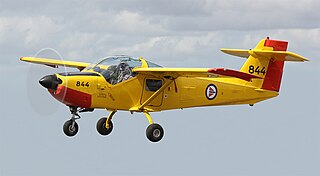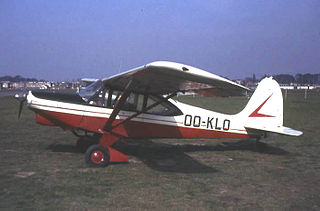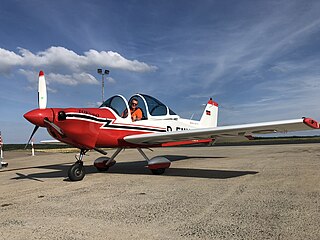Bölkow was a West German aircraft manufacturer based in Stuttgart, Germany, and later Ottobrunn.

The Falco F8L is an Italian-designed lightweight 2-seater aerobatic aircraft.

The Victa Airtourer is an all-metal light low-wing monoplane touring aircraft that was developed in Australia, and was manufactured in both Australia and New Zealand.

Saab MFI-15 Safari, also known as the Saab MFI-17 Supporter, is a propeller-powered basic trainer aircraft used by several air forces.

The Boisavia B.60 Mercurey was a series of four-seat light aircraft developed in France shortly after World War II.

The Bölkow Bo 207 was a four-seat light aircraft built in West Germany in the early 1960s, a development of the Klemm Kl 107 built during World War II.

The Klemm Kl 107 was a two-seat light aircraft developed in Germany in 1940. It was a conventional low-wing cantilever monoplane of wooden construction with fixed tailwheel undercarriage. Wartime production totalled only five prototypes and some 20 production machines before the Klemm factory was destroyed by Allied bombing. Following World War II and the lifting of aviation restrictions on Germany, production recommenced in 1955 with a modernised version, the Kl 107B, of which Klemm built a small series before selling all rights to the design to Bölkow. This firm further revised the design and built it as the Kl 107C before using it as the basis for their own Bo 207.

The Oberlerchner JOB 15 was an Austrian two-seat light aircraft produced by Josef Oberlerchner Holzindustrie, which had previously designed and built gliders.

The MBB 223 Flamingo was a light aircraft developed in West Germany in the 1960s in response to a competition for a standard trainer for the country's aeroclubs. Designed by SIAT, it was a conventional low-wing monoplane with fixed tricycle undercarriage. The cockpit was enclosed by a large bubble canopy. SIAT had not undertaken much production of the type before the firm was acquired by MBB in 1970. Eventually, the new owners transferred production to CASA in Spain.

The DINFIA IA 45 Querandi was a 1950s Argentine twin-engined light transport aircraft built by the DINFIA.
The Falconar Teal was a two-seat homebuilt, amphibious airplane designed by Chris Falconar of Edmonton, Alberta, Canada. From the 1970s to the 1990s plans were sold by Falconar Aviation of Edmonton. A handful were built by amateur aircraft constructors in Canada and the United States. Most were powered by certified Lycoming or Continental engines.

The Malmö MFI-10 Vipan was a four-seat light utility monoplane designed and built in Sweden by Malmö Flygindustri. Only three aircraft were built and the type did not enter quantity production.

The Wassmer WA-40 Super 4 Sancy is a French single-engined light aircraft of the 1960s and 70s. A single-engined low-winged monoplane with retractable nosewheel undercarriage, variants include the more powerful WA 4/21 Prestige and the WA-41 Baladou with a fixed undercarriage.

The Varga 2150 Kachina is an American all-metal, low-wing, fixed-gear, two-seat light aircraft fitted with a tricycle undercarriage.

The Robin R 3000 is a French single-engined light aircraft designed and built by Avions Robin, which entered production in the 1980s.

The Gazuit-Valladeau GV-103 Gazelle was a French-built light two- to four-seat training, aerobatic and touring aircraft of the late 1960s.

The Mylius family of aircraft were derived from the barn-built MHK-101 design, which later was adopted by MBB and became the Bölkow Bo 209 Monsun project. The Bo-209 was a full metal, low wing basic trainer with standard aerobatic capabilities, 150 hp O-320 or 160 hp IO-320 engine. The front wheel was retractable. Both wings were foldable, thus permitting to trailer the aircraft by a car on its own main wheels, nose wheel retracted and tail forward.

The Mylius My-103 Mistral is a German two-seat aerobatic trainer of utility aircraft produced by Mylius Flugzeugwerk of Bitburg.

The Mylius My 102 Tornado is a prototype single-seat German aerobatic aircraft. It was designed as a smaller derivative of the MBB Bo 209, but was not placed in production, with only two aircraft built.


















